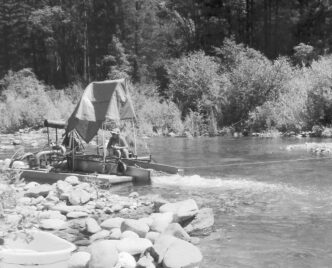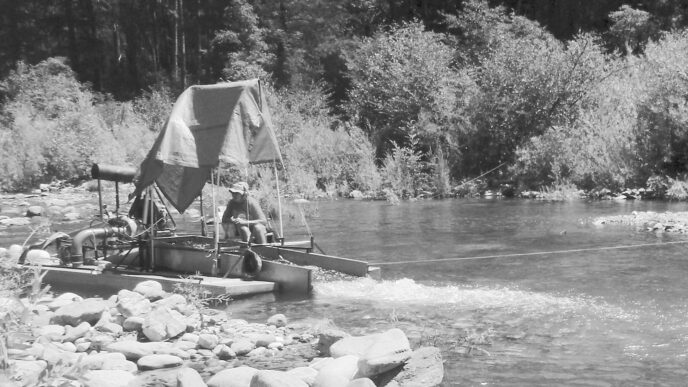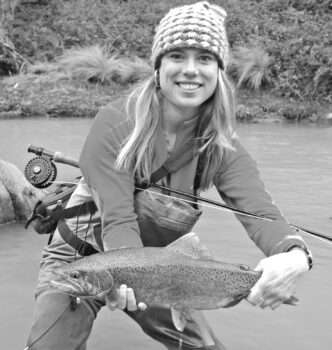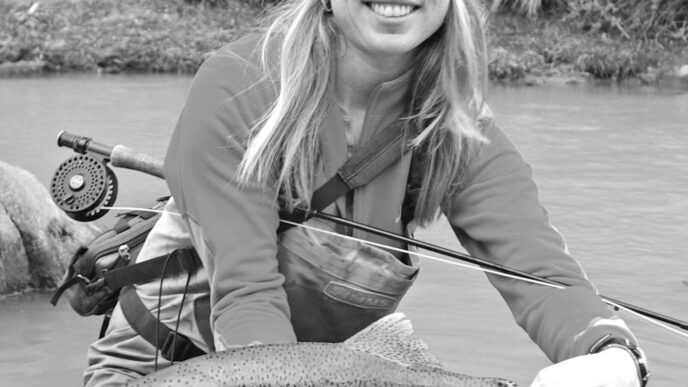Hat creek is the poster child for what happens to trout populations when stream habitat gets trashed, but that may soon change. The trout population in this spring creek’s blue-ribbon, special-regulation section that runs between Lake Britton and Baum Lake, just east of the town of Burney in Shasta County, has plummeted from some 5,000 fish per mile in the 1980s to around 2,000 per mile in 2010.
More has gone wrong than has gone right at Hat Creek. Sediment from an unknown source is slowly moving downstream. Cattle grazing over time and, more recently, unauthorized off-highway-vehicle use have degraded meadows and riparian areas. Trees have been cut, depriving the stream in places of water-cooling cover. Yellow star thistle and other noxious plants have been pervasive in the watershed. Invasive weeds have replaced native aquatic vegetation and are choking spawning areas. Muskrats chew holes in the stream banks, which then collapse and cause erosion. Historically, flows have been managed to benefit power generation, rather than fish.
Now California Trout and its partners are ramping up efforts to restore the wildtrout portion of the beleaguered creek, which was the first in the state to be earmarked for protection under the 40-year-old Wild Trout Program. “The slow deterioration of Hat Creek, brought on by a combination of unrelated issues, including cattle grazing and burrowing by nonnative muskrats, is creating a crisis condition for trout,” said Drew Braugh, staff member for CalTrout, a San Francisco–based nonprofit that will spend some $850,000 toward restoration of stream.
Recently, the California Natural Resources Agency awarded CalTrout a $650,000 grant for the work from Proposition 84 funds that voters approved in 2006. In addition, CalTrout has raised another $200,000 in private donations for the project. “The funds secured today will go a long way toward creating habitat in which these native fish can thrive,” said Braugh at an event announcing receipt of the state grant. “We also did some fundraising as part of what we call our Blue Waters Program,” said Braugh, who works in CalTrout’s Mount Shasta Regional Office in Redding. “It focuses on how to protect California’s best trout waters.”
Dubbed the Hat Creek River Parkway Project, restoration is expected to begin in June 2013, depending on completion of the permitting process by CalTrout and its partners, which include the land owner, Pacific Gas & Electric Company, plus the UC-Davis Center for Watershed Sciences and the California Department of Fish and Wildlife (DFW), the state agency that was until recently named the California Department of Fish and Game. Work should be completed in two years, Braugh added, but those involved have planned for a third year, if needed, to deal with unexpected circumstances. The groups have set a goal of returning the population of the creek’s rainbows and brown trout to a density of 5,000 fish per mile.
According to Braugh, the funds will be used to place large woody debris such as logs and trees in the creek to provide cover for fish, plant about 6.3 acres of willows, alders, and native vegetation in most of the riparian corridor, and construct a 1.5-mile trail to improve access for hiking and fishing along a route that disperses anglers in order not to degrade the stream or trout population further. A half mile of the trail will be paved and wheelchair accessible.
“Now, anglers concentrate in a couple of areas,” said Braugh. “People hammer the Powerhouse riffle. We want to distribute the anglers in the wild-trout area and protect the stream banks and channel.” Braugh said that signs will be erected to inform anglers about how to fish responsibly in the sensitive stream. In the designated wild-trout section, there is an 18-inch minimum size limit and a two-fish limit, and anglers can only use artificial lures and flies with barbless hooks.
Other strategies that have been adopted include improving water quality, water temperatures, and dissolved-oxygen content to levels that sustain a fishery, engaging UC-Davis to monitor the creek and assess and prioritize threats and objectives, building a coalition of stakeholders to serve as an advisory group for the restoration effort, and transferring the wild-trout area from PG&E to a conservation entity.
Efforts to create a sustainable wildtrout fishery at Hat Creek have been going on for nearly 50 years. In 1968, CalTrout and state fishery officials constructed a fish barrier across the lower stream to block Sacramento suckers from overpopulating the creek, chemically treated the creek to eradicate invasive fish, restocked the creek with strains of wild trout, and decreased overharvesting of trout by dropping the bag limit from 10 to 2 fish per day.
Over the years, the planning and restoration effort has served as a model for how public and private agencies can cooperate to protect and enhance a stream and its wild-trout population. “The reason this is happening is because the agencies and private industry are working really hard together,” said Braugh. “Hat Creek will serve as a unique model, one we can replicate elsewhere in the state.”
The project is one of the first since California fish-and-wildlife officials adopted a strategy of encouraging such public-private partnerships in their “Vision” plan that sets priorities for the future. For the Hat Creek project, DFW leadership has been provided by Mike Berry, a senior environmental scientist, and Mike Dege, a wild-trout and permitting specialist.
While the DFW provides technical support, CalTrout will face a policy decision on how to deal with the muskrat population that live along the stream. At one time, a company raised muskrats for pelts at the creek, but then went bankrupt, leaving a thriving population of two-foot-long rodents that burrow into the banks of the channel. According to wildlife scientists, female muskrats can have up to five litters per year, each with as many as 10 young. Braugh said that the erosion damage caused by the muskrats has diminished since there are no longer cattle along the creek to collapse the hole-ridden banks. But the muskrat population remains a problem.
Here is other fish-related news from around the state.
Webber Lake and Little Truckee River Headwaters Protected
The Truckee Donner Land Trust and the Trust for Public Land, working together with the Northern Sierra Partnership, closed an $8 million land purchase in November that permanently protects 3,000 acres of land at the headwaters of the Little Truckee River, including Webber Lake and Lacey Meadows.
Most of the property, which is situated off of Henness Pass Road north of Truckee, will now be open for non-motorized use by the public, with free access. Webber Lake, a 260-acre natural impoundment that has served as a private fishing camp since the 1860s, will be managed for the next four years by a concessionaire as a pay-to-play, catch-and-release fishery. After that, it will open to the public. For anglers interested in visiting, Webber is fishable from ice-out around mid-May to mid-October for $75 per day by reservation for midweek angling. Season passes are available for $450, plus a $50 refundable charge for a key to the access gate. The lake’s campground, also operated by the concessionaire, is booked, but anglers can add their names to a waiting list. For more information about lake access, contact Ken and Joan Bretthauer by e-mail at kbretthauer@att.net or by phoning (530) 993-0300. Tributary streams on the property are not part of the concession arrangement and can be fished by the public at no charge.
New Wild Trout Waters Designated
Anglers will have to hike to get to the two latest waters added to the state’s Wild Trout Program, but the reward could be catching a feisty golden or trophy-sized brown trout. California’s Fish and Game Commission has designated the South Fork of the San Joaquin River and the Sallie Keyes Lakes in Fresno County as Wild Trout Waters. The two areas are known for breathtaking scenery, and the newly designated waters harbor a population of California golden trout and huge browns.
To be designated, waters must be able to support self-sustaining trout populations, be aesthetically pleasing and environmentally productive, provide adequate catch rates, are not stocked with catchable-sized hatchery trout, and must be open to public angling.
According to the DFW, “the designation boundaries include the ‘South Fork San Joaquin River and all tributaries from Florence Lake upstream to the boundary with Kings Canyon National Park, including the Piute Creek drainage (Fresno County).’” In addition, the “Sallie Keyes Lakes (Fresno County) are located within this watershed and consist of two lakes situated along the Pacific Crest Trail above 10,000 feet elevation near Selden Pass.”
With the inclusion of these waters in the Heritage and Wild Trout Program, there are now a total of 44 waters so designated across the state. They encompass more than 1,400 miles of stream habitat and 11 lakes. For more information on California’s Wild Trout Program waters, go to sources/WildTrout.
Critical Comments Kick Off Latest Delta Protection Effort
The latest round of the water wars over the Sacramento–San Joaquin Delta has apparently started, even though the state has yet to release its long-range plan for the Delta. A representative of a coalition of some 40 angling and conservation groups kicked off the debate by saying that the provisions contained in a “predraft” of the state’s Bay Delta Conservation Plan (BDCP) result in “an impending environmental and financial disaster.” Nick Di Croce of the Environmental Water Caucus told state officials that the members of his organization question the effectiveness of untested environmental strategies in the plan, its real cost for fixing the Delta, and the lack of sources of funds and water for the project.
The “predraft” of the state’s plan proposes construction of two 35-mile-long tunnels to route water around the troubled estuary, which contains threatened and endangered fish populations. The massive underground pipes would take Sacramento River water from near Sacramento and transport it to the export pumps at Tracy, thus bypassing the Delta. In 1982, state voters rejected a similar water bypass plan, then known as the Peripheral Canal.
Di Croce said the state should implement proven, cost-effective strategies for saving the Delta before building the expensive tunnels. He said that the California State Water Board should adopt policies that include more aggressive water conservation, reducing water exports from the Delta, allowing the water to be used for threatened local farmlands in the San Joaquin Valley, installing fish screens in the South Delta, continuing pumping restrictions to protect fish, and strengthening the levee system in the Delta.
At the hearing, state water officials said the list of strategies was released early in order to gather comments from the public on the highly contentious issue. Deputy Natural Resources Secretary Jerry Meral said that state and federal officials would release an official draft of the BDCP plan in late January or early February 2013. He said the draft analysis of the project’s environmental impact would be available for public review in the spring of 2013. State officials hope to adopt the final plan by the end of 2013.
A goal of the plan is to protect and enhance populations of Sacramento River chinook salmon, Central Valley steelhead, striped bass, largemouth bass, Delta smelt, longfin smelt, green and white sturgeon, and other fish that rely on the Delta and its waters. At the hearing, Meral said the BDCP would include an analysis of the potential costs and benefits to water users and to the public.
Members of the Environmental Water Caucus include the California Sportfishing Protection Alliance, the California Striped Bass Association, the Friends of the River, the Granite Bay Flycasters, the Institute for Fisheries Resources, the Karuk Tribe, the Northern California Council of the Federation of Fly Fishers, the Pacific Coast Federation of Fishermen’s Associations, Restore the Delta, and others. Details of the Environmental Water Caucus plan can be found at http://www.ewccalifornia.org.
Kellogg Gets Award from California Outdoor Writers
Jim Kellogg, president of the California Fish and Game Commission, has received the Californian of the Year Award from a state group of outdoor writers. The Outdoor Writers Association of California gives the annual award to a person who has contributed significantly to the promotion of outdoor recreation and preserving nature and who has exemplified the spirit of the outdoors. Kellogg, a 10-year member of the commission, has “consistently displayed a balanced sense of fair play regarding the environment, conservation, and preservation of California’s natural resources,” stated a press release from the association. A resident of Discovery Bay, Kellogg works for a labor union representing plumbers and pipefitters. He is a longtime hunter and angler.
Game Warden Group Receives $1.8 Million Challenge Pledge
Board members and staff of the California Game Wardens Foundation have kicked off a fundraising drive to raise $1.8 million in order to match a pledge of a similar amount by an anonymous donor. The five-year-old private Menlo Park based nonprofit foundation raises funds to pay for training and equipment for state game wardens. According to Judd Hanna, a foundation board member who lives in Mill Creek, the fundraising drive is part of the group’s effort to create a $5 million permanent endowment to support the work of game wardens. Information about the foundation is available at http://www.calgwf.org.













